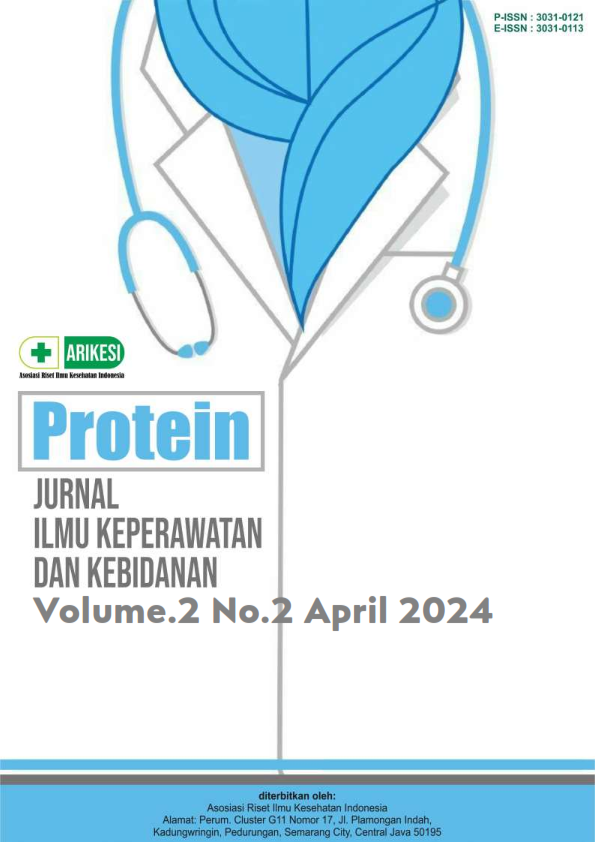Gambaran Keterampilan Ibu Tentang Cara Memandikan Bayi Pada Ibu Postpartum Di PMB SR
DOI:
https://doi.org/10.61132/protein.v2i2.324Keywords:
Bathing Baby, Newborn, Postpartum MomAbstract
Background: one of the activities that create a bonding between mother and child is bathing the baby. But most mothers are afraid when doing it, this is because the baby's physical condition is still weak. Therefore, it is important for postpartum mothers to know how to bathe the baby correctly and safely. However, based on preliminary studies conducted at PMB SR, it was found that most postpartum mothers still use shamans or in-laws to bathe their babies. Objective: to determine the skills overview postpartum mothers in PMB SR. The benefits of research for the population in the research area are to increase the knowledge and skills of postpartum mothers about how to bathe babies properly and safely, so as to prevent hypothermia, infection, and infant death, and increase bonding attachment between mother and baby. Research design: this study uses a descriptive design with a cross sectional approach. the population of all postpartum mothers in PMB SR who met the inclusion criteria amounted to 30 people in the period 08 May - 08 June 2023 the measuring instrument in this study was the baby bathing skills checklist. Results: from the results of descriptive analysis obtained, respondents with skilled categories of 7 people (23%), and unskilled obtained 23 people (77%). Discussion: based on the results obtained, most postpartum mothers are not skilled in bathing their babies. It is expected that this study can be used as data to improve the skills of mothers by changing the method in the class of pregnant women from lectures to a combination of lectures and demonstrations.
Downloads
References
Bobak, L. (2012). Buku Ajar Keperawatan Maternitas. Jakarta: EGC.
Depkes RI. (2013). Laporan Hasil Riset Kesehatan Dasar Indonesia. Jakarta: Badan Penelitian dan Pengembangan Kesehatan.
Heru, A. M. (2006). Penelitian Kualitatif untuk Ilmu-ilmu Kemanusiaan dan Budaya. Jakarta: Gunadarma.
Hiadayah, N., Santoso, B. R., & Rukayani, S. A. (2015). Gambaran Pengetahuan Ibu Nifas Tentang Memandikan Bayi Di Klinik Firdaus Banjarmasin. Dinamika Kesehatan: Jurnal Kebidanan Dan Keperawatan, 6(1), 113–120.
Hidayat. (2009). Asuhan Neonatus, Bayi, dan Balita: buku praktikum mahasiswa kebidanan. Jakarta: Rineka Cipta.
Hikmah, R. (2016). Hubungan BBLR Dengan Kejadian Hipotermia Pada Bayi. OKSITOSIN, KEBIDANAN, VOL. III, NO. 2, 101-106.
Iverson. (2001). Memahami Keterampilan Pribadi. Bandung : CV Pustaka.
Kemenkes RI. (2017). Profil Kesehatan Republik Indonesia. Jakarta: Depkes RI.
Kemenkes RI. (2020). Buku Saku Pelayanan Kesehatan Neonatal Esensial. Jakarta: Departemen Kesehatan.
Maritalia, D. (2017). Asuhan Kebidanan pada Ibu Postpartum. (S. Riyadi, Ed.). Yogyakarta: Gosyen Publishing.
Marmi, S. S. (2015). Asuhan Neonatus Pada Bayi, Balita,dan Anak Prasekolah. Jakarta: Pustaka Belajar.
Noordiati. (2018). Asuhan Kebidanan, Neonatus, Bayi, Balita, Dan Anak Pra Sekolah. Malang: Wineka Media.
Notoadmodjo, S. (2003). Ilmu Kesehatan Masyarakat. Jakarta: PT. Rineka Cipta.
Nursalam & Efendi, S. (2008). Pendidikan Dalam Keperawatan. Jakarta: Salemba Medika.
Putra, S. (2012). Asuhan Neonatus: bayi dan balita untuk keperawatan dan Kebidanan. Yogyakarta: D-Medika.
Rahmawati, N. E. (2011). Ilmu Praktis Kebidanan. Surabaya: Victory Inti Cipta.
Robbins, S. (2006). Organizational Behavior (alih bahasa oleh Benyamin Molan). Jakarta: Kelompok Gramedia.
Rochmah. (2012). Asuhan Neonatus, Bayi, Dan Balita. Jakarta: EGC
Saifuddin, Abdul Bari. 2002. Ilmu Kebidanan. Jakarta : Yayasan Bina Pustaka Sarwono Prawirohardjo
Saputra. (2014). Asuhan Kebidanan, Neonatus Normal dan Patologis. Tangerang: Binarupa Aksara.
Sholeh, M., Yunanto, A., Dewi, R., & Usman, A. (2014). Buku Ajar Neonatologi. Jakarta: Ikatan Dokter Anak Indonesia.
Silaban, C. (2017). Kelangsungan Hidup Bayi Berat Lahir Rendah pada masa Neonatus dan Faktor-faktor yang Berkontribusi di Kabupaten Magelang. Universitas Gadjah Mada, 5 (1).
Widyatun. (2005). Ilmu Perilaku. Jakarta: Rineka Cipta.
Wulandari, V. (2010). Faktor-faktor yang mempengaruhi keterampilan ibu nifas dalam perawatan tali pusat di wilayah kerja Puskesmas Cipanas Kab. Cianjur. In Karya Tulis Ilmiah. Bandung.
Yuliana W & Hakim B.N. (2020). Emodemo Dalam Asuhan Kebidanan Masa Postpartum. Jakarta: Yayasan Ahmar Cendekia Indonesia.Bobak, Lowdermilk, J. (2004). Buku Ajar Keperawatan Maternitas (Edisi 4). Jakarta: EGC.
Downloads
Published
How to Cite
Issue
Section
License
Copyright (c) 2024 Protein : Jurnal Ilmu Keperawatan dan Kebidanan.

This work is licensed under a Creative Commons Attribution-ShareAlike 4.0 International License.





